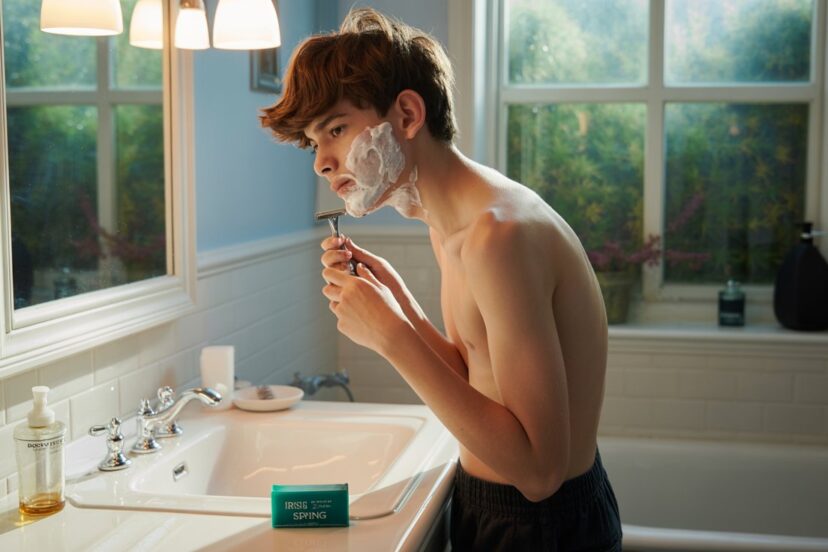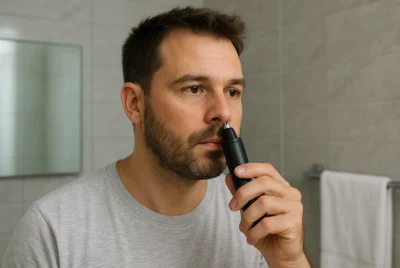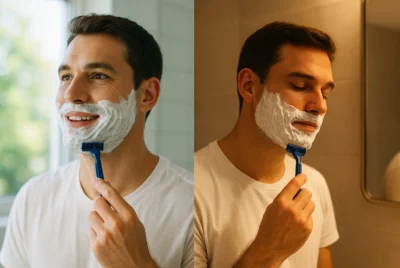Best Shaving Tips for Teenagers
Post Disclaimer
*We may earn a commission for purchases made using our links. Please see our disclosure to learn more.
The bathroom mirror reflects a face that’s changing daily. Peach fuzz has transformed into something more noticeable, and suddenly, the idea of shaving doesn’t seem so distant. For many teenagers, that first shave represents more than just hair removal—it’s a milestone, a step toward independence, and sometimes, a source of anxiety.
The teenage years bring unique challenges when it comes to personal grooming. Hormonal changes create sensitive skin, irregular hair growth patterns, and acne concerns that adult shavers rarely face. Understanding these challenges and learning proper shaving techniques can transform what might feel like a daunting task into a confident, daily routine.
“The first shave is a rite of passage that marks the beginning of adulthood, but it doesn’t have to be intimidating with the right knowledge and preparation.”
– American Academy of Dermatology
Key Takeaways
- Start with preparation: Clean skin and proper tools are essential for a successful shave
- Choose the right razor: Electric shavers offer safety for beginners, while safety razors provide closer results
- Use proper technique: Shave with the grain, use light pressure, and take your time
- Post-shave care matters: Moisturizing and treating irritation prevents long-term skin issues
- Build gradually: Start with every few days rather than daily shaving to let skin adjust
- Address acne carefully: Special techniques help navigate breakouts without worsening them
Recommended Shaving Products for Teenagers
1. Gillette SkinGuard Sensitive Razor
The Gillette SkinGuard Razor is specially designed for men with sensitive skin, razor bumps, and acne. With its unique SkinGuard positioned between the blades, this razor minimizes blade contact to reduce irritation and help protect skin prone to breakouts. The lubrication before and after the blades ensures a smooth glide, while the precision trimmer on the back allows for easy styling in hard-to-reach areas. Perfect for those who struggle to shave with acne, this razor delivers comfort without sacrificing performance.
- Gentle Design: Reduces irritation for acne-prone and sensitive skin.
- Lubrication: Provides added glide for a smoother shave.
- Precision Trimmer: Ideal for shaping facial hair in tricky spots.
- Less Close Shave: Prioritizes comfort over ultra-close results.
- Limited Blade Count: Only 2 blades, less aggressive than multi-blade razors.
- Handle Compatibility: Only fits SkinGuard handles.
This razor features a guard between the blades that smooths skin and reduces blade contact, making it ideal for sensitive teenage skin prone to irritation.
2. Cremo Original Shave Cream
Cremo Barber Grade Original Shaving Cream is your go-to solution for an ultra-slick, irritation-free shave. Designed with advanced molecules, it creates a frictionless surface for your razor to glide effortlessly, delivering a close, comfortable shave without nicks or razor burn. Its paraben-free formula suits all skin types, making it a versatile choice for anyone seeking a professional-grade shave at home. The refreshing original scent adds a clean, invigorating finish to your grooming routine. With a 90-day supply in each bottle, Cremo ensures long-lasting value and superior performance that elevates your daily shave.
- Astonishing slickness: Provides an exceptionally smooth surface for a close shave.
- Value for money: A single 6 oz bottle lasts up to 90 days.
- Fights irritation: Reduces razor burn, nicks, and cuts effectively.
- Minimal lather: May not foam as much as traditional shaving creams.
- Requires precise application: Too much or too little can affect performance.
- Limited scent variety: Fewer options compared to competitors.
A concentrated formula that provides excellent lubrication and protection without clogging pores—perfect for acne-prone skin.
3. Philips Norelco OneBlade Face + Body
The Philips Norelco OneBlade 360 is a versatile grooming tool designed to trim, edge, and shave any beard length with ease. Featuring innovative 360 Blade Technology, it flexes in all directions for optimal skin contact, allowing for a smooth and comfortable grooming experience with fewer passes. The fast-moving cutter (12,000x per minute) ensures efficiency, while the dual protection system minimizes irritation. Whether used wet or dry, its lightweight design and USB charging make it the perfect companion for home or travel.
- Adaptive Shaving Technology – The flexible 360 Blade adapts to facial contours for precise grooming.
- Customizable Length Settings – The 5-in-1 adjustable comb allows for customizable stubble length (1-5mm).
- Wet & Dry Use – The water-resistant design enables use in or out of the shower.
- No Power Adapter Included – Comes with a USB charging cable only, requiring a separate adapter.
- Short Battery Life – The battery lasts 45 minutes, which may require frequent recharging.
- Not a Clean Shave – Designed to leave light stubble, not a completely smooth finish.
An electric option that trims, edges, and shaves any length of hair, offering versatility for different grooming needs and reducing the risk of cuts.
4. Nivea Men Sensitive Post Shave Balm
NIVEA MEN Post Shave Balm is the perfect solution for men seeking relief from post-shave irritation. This 3-pack of 3.3 fl oz bottles is specially formulated to soothe and hydrate sensitive skin with Vitamin E, Chamomile, and Witch Hazel extracts. Designed to fight the five common signs of shaving irritation—burning, micro-cuts, dryness, tightness, and stubble itch—it leaves your skin feeling smooth and refreshed. This fast-absorbing, lightweight balm moisturizes without leaving a greasy residue, making it ideal for everyday use. Dermatologically tested, it's a must-have for anyone with sensitive skin who wants a comfortable and irritation-free shave experience.
- Soothes and Hydrates: Helps calm sensitive skin with Vitamin E and Chamomile extract.
- Quick Absorption: Lightweight, fast-absorbing formula without greasiness.
- Multiple Benefits: Addresses 5 signs of irritation for a smoother, more comfortable shave.
- Travel Size: While convenient, some may prefer a larger bottle.
- Fragrance: Might not be suitable for those sensitive to scented products.
- Not for All Skin Types: May not be ideal for extremely dry or damaged skin.
An alcohol-free aftershave balm that soothes irritation and moisturizes without causing breakouts, specifically formulated for sensitive skin.
Understanding Teenage Facial Hair Development
Facial hair development during adolescence follows a predictable but individually variable pattern. Most young men begin noticing fine, light-colored hair around age 14-16, typically starting on the upper lip and chin areas. This initial growth, often called “peach fuzz,” gradually becomes coarser and darker as hormone levels stabilize.
The irregular nature of teenage facial hair presents unique challenges. Unlike mature facial hair that grows in consistent patterns, adolescent hair often appears patchy, with some areas growing faster than others. This uneven development can make teenagers feel self-conscious, leading to the desire to start shaving before the hair is substantial enough to require regular removal.
Understanding that this development is completely normal helps reduce anxiety around the shaving process. The key is learning to work with these growth patterns rather than against them, adapting techniques as facial hair continues to mature.
Pre-Shave Preparation: The Foundation of Good Shaving
Skin Preparation
Proper preparation sets the stage for a comfortable, effective shave. Begin by washing the face with warm water and a gentle cleanser to remove dirt, oil, and dead skin cells. The warm water helps soften facial hair, making it easier to cut and reducing the force needed during shaving.
For teenagers dealing with acne, this cleansing step becomes even more critical. Use a salicylic acid or benzoyl peroxide cleanser if recommended by a dermatologist, but avoid over-cleansing, which can increase oil production and irritation.
Creating the Right Environment
The bathroom environment plays a crucial role in shaving success. Ensure adequate lighting—natural light is ideal, but a well-lit vanity mirror works too. Poor lighting leads to missed spots and increases the likelihood of cuts or irritation.
Steam from a hot shower can help soften facial hair naturally. Many experienced shavers prefer to shave immediately after showering when hair is at its softest. However, if time doesn’t permit, applying a warm, damp towel to the face for 2-3 minutes achieves similar results.
Choosing the Right Shaving Tools
Razor Selection for Beginners
The choice between electric and manual razors often depends on personal preference, skin sensitivity, and lifestyle factors. Electric razors offer safety advantages for beginners, virtually eliminating the risk of cuts while providing adequate hair removal for fine teenage facial hair.
Manual razors, particularly safety razors with fewer blades, can provide closer shaves but require more technique and caution. Multi-blade cartridge razors, while popular, can sometimes cause more irritation on sensitive teenage skin by making multiple passes with each stroke.
Shaving Cream vs. Gel vs. Foam
The lubricant used during shaving significantly impacts comfort and results. Traditional shaving creams offer superior protection and lubrication, creating a rich lather that cushions the skin. They’re particularly beneficial for sensitive skin and those prone to irritation.
Shaving gels provide good visibility, allowing shavers to see exactly where they’re shaving—helpful when navigating around acne or learning proper technique. However, some gels contain ingredients that can clog pores, making them less ideal for acne-prone teenagers.
Avoid aerosol foams with numbing agents, as these can mask the sensation needed to shave safely and often contain harsh chemicals that irritate young, sensitive skin.
Proper Shaving Technique for Teenagers
The Importance of Grain Direction
Understanding hair growth direction, or “grain,” is fundamental to comfortable shaving. Facial hair doesn’t grow uniformly in one direction; instead, it follows various patterns across different areas of the face. On most faces, hair on the cheeks grows downward, while chin hair might grow in multiple directions.
For teenagers just starting to shave, identifying these patterns takes time and observation. Gently run fingers across the face in different directions—the smoothest direction indicates shaving with the grain, while the rougher direction goes against it.
Always begin by shaving with the grain. This approach minimizes irritation and reduces the risk of ingrown hairs, particularly important for teenagers whose skin is still adjusting to the shaving process.
Pressure and Angle Control
One of the most common mistakes new shavers make is applying too much pressure. The razor’s weight should provide sufficient force to cut hair effectively. Excessive pressure increases the likelihood of cuts, razor burn, and ingrown hairs.
Maintain a 30-degree angle between the razor and skin surface. This angle provides optimal cutting efficiency while minimizing skin irritation. Take short, controlled strokes rather than long sweeping motions, rinsing the razor frequently to prevent hair and cream buildup.
Navigating Acne and Sensitive Areas
Teenage skin often presents additional challenges in the form of acne breakouts. When shaving around pimples and sensitive areas, extra care prevents worsening existing conditions or creating new problems.
For active breakouts, consider using an electric razor set to a longer setting to avoid directly contacting inflamed areas. If using a manual razor, stretch the skin gently to create a flat surface around blemishes, but avoid applying pressure directly to affected areas.
Some dermatologists recommend shaving every other day initially, allowing skin time to heal between sessions. This approach helps prevent the cycle of irritation that can worsen acne conditions.
Post-Shave Care and Skin Health
Immediate Aftercare
The moments immediately following a shave are crucial for skin health and comfort. Rinse the face with cool water to remove any remaining shaving cream and close pores. Pat the skin dry with a clean towel—avoid rubbing, which can irritate freshly shaved skin.
Apply an alcohol-free aftershave balm or moisturizer while the skin is still slightly damp. This helps lock in moisture and provides ongoing protection throughout the day. Products containing aloe vera, chamomile, or other soothing ingredients can help reduce any immediate irritation.
Long-Term Skin Care Integration
Shaving should integrate seamlessly with an existing skincare routine rather than replacing it. For teenagers using acne medications, timing becomes important. Generally, it’s best to shave before applying topical treatments, allowing the medication to penetrate freshly exfoliated skin more effectively.
However, some acne medications can increase skin sensitivity. If using retinoids, benzoyl peroxide, or other strong treatments, consider shaving every other day or using an electric razor to reduce irritation.
Dealing with Common Shaving Problems
- Razor Burn: This red, irritated appearance results from too much pressure, dull blades, or shaving against the grain. Treatment involves cooling the skin with a cold compress and applying a gentle, fragrance-free moisturizer.
- Ingrown Hairs: These occur when hair grows back into the skin rather than outward. Prevention includes exfoliating regularly, shaving with the grain, and avoiding multiple passes over the same area.
- Cuts and Nicks: Minor cuts are common when learning to shave. Keep styptic pencils or alum blocks on hand to stop bleeding quickly. More importantly, focus on prevention through proper technique and sharp blades.
Building Confidence Through Proper Technique
Starting Slowly and Building Skills
The pressure to achieve a perfect shave immediately can lead to frustration and poor habits. Instead, focus on developing proper technique gradually. Begin by shaving just once or twice per week, concentrating on areas with the most noticeable hair growth.
As comfort and skill develop, gradually increase shaving frequency. Pay attention to how skin responds—some teenagers can shave daily without issue, while others need rest days to prevent irritation.
Learning from Mistakes
Every experienced shaver has stories of early mistakes—cuts, missed spots, and irritation are part of the learning process. Rather than becoming discouraged, view these experiences as learning opportunities that contribute to skill development.
Keep a simple shaving journal noting what works and what doesn’t. Track which products provide the best results, optimal shaving frequency, and any patterns in skin sensitivity. This information becomes invaluable for developing a personalized routine.
Addressing Common Concerns and Myths
Will Shaving Make Hair Grow Back Thicker?
This persistent myth causes unnecessary anxiety for many teenagers. Shaving cuts hair at the skin’s surface, affecting neither the hair follicle nor the hair’s genetic characteristics. The appearance of thicker hair after shaving results from the blunt cut edge being more noticeable than naturally tapered hair tips.
When Should Shaving Begin?
There’s no universal age or hair density threshold for beginning to shave. The decision should be based on personal comfort, social considerations, and practical necessity rather than arbitrary guidelines.
Some teenagers prefer to start shaving when facial hair becomes socially noticeable, while others wait until growth patterns are more established. Both approaches are valid, and the timing should reflect individual preferences and circumstances.
Electric vs. Manual: Making the Right Choice
The debate between electric and manual razors often focuses on closeness of shave versus convenience and safety. For teenagers, factors like skin sensitivity, time constraints, and confidence level should guide this decision.
Electric razors offer consistency and safety, making them excellent choices for beginners or those with very sensitive skin. Manual razors provide versatility and can achieve closer results but require more skill and time to master.
Creating Sustainable Shaving Habits
Developing a Routine
Consistency in shaving routine helps skin adapt and improves overall results. Establish a regular schedule that fits with other daily activities—many people prefer morning shaves for a fresh start to the day, while others find evening shaves more relaxing.
The routine should include pre-shave preparation, the shaving process itself, and post-shave care. This comprehensive approach ensures optimal results and maintains skin health over time.
Budget-Conscious Approaches
Teenagers often have limited budgets for grooming supplies, making cost-effectiveness important. Focus on quality basics rather than expensive gadgets—a good razor, quality shaving cream, and effective aftercare products provide better value than numerous specialty items.
Consider safety razors for long-term savings. While the initial investment is higher, replacement blades cost significantly less than cartridge refills, making them economical over time.
Adapting to Changing Needs
Facial hair continues evolving throughout the teenage years and into early adulthood. Techniques and products that work well initially may need adjustment as hair becomes coarser, growth patterns change, and skin matures.
Stay flexible and willing to experiment with different approaches. What works for friends or family members may not be ideal for your specific skin type and hair characteristics.
The Broader Impact of Good Grooming
Confidence and Self-Image
Mastering basic grooming skills like shaving contributes to overall confidence and self-image during the already challenging teenage years. The ability to maintain a neat, well-groomed appearance can boost self-esteem and social confidence.
However, it’s important to maintain perspective—good grooming should enhance natural confidence rather than masking insecurities. The goal is developing skills that support overall well-being rather than creating pressure for perfection.
Social and Professional Benefits
As teenagers prepare for job interviews, social events, and increased independence, grooming skills become increasingly important. A neat, well-maintained appearance communicates attention to detail and personal responsibility.
These skills also demonstrate respect for others in social and professional situations. While individual expression should always be valued, understanding when and how to present a polished appearance provides valuable flexibility.
Environmental and Health Considerations
Sustainable Shaving Practices
Environmental consciousness increasingly influences consumer choices, and shaving practices offer opportunities for more sustainable approaches. Safety razors with replaceable blades generate less plastic waste than disposable cartridge systems.
Choosing shaving soaps or creams with minimal packaging, natural ingredients, and biodegradable formulations supports environmental goals while often providing superior performance.
Ingredient Awareness
Teenagers with sensitive skin benefit from understanding common irritating ingredients in shaving products. Fragrances, alcohol, and certain preservatives can cause reactions in sensitive individuals.
Reading ingredient lists and choosing products with minimal, recognizable ingredients often leads to better results for sensitive skin. When in doubt, patch test new products on a small skin area before full-face application.
Conclusion
Learning to shave represents more than just acquiring a grooming skill—it’s about developing confidence, responsibility, and self-care habits that extend far beyond the bathroom mirror. The journey from that first tentative shave to confident, daily grooming reflects broader growth and maturation.
The key to successful shaving lies in patience, proper technique, and understanding that everyone’s experience is unique. What works perfectly for one person may need adjustment for another, and that’s completely normal. The important thing is starting with good foundational knowledge and adapting techniques based on individual needs and responses.
Remember that perfect shaves aren’t achieved overnight. Even experienced shavers occasionally deal with irritation, missed spots, or other minor issues. The goal isn’t perfection but rather developing sustainable habits that support overall well-being and confidence.
As facial hair continues to develop and change throughout the teenage years and beyond, remain open to adjusting techniques and trying new approaches. The skills learned during these early shaving experiences will serve well throughout life, contributing to overall grooming competence and personal confidence.
Most importantly, view shaving as just one aspect of overall self-care rather than a source of stress or anxiety. With proper knowledge, quality tools, and patience, what might initially seem daunting becomes a simple, routine part of daily life—one that supports confidence and helps present the best version of yourself to the world.
Frequently Asked Questions
Q: How often should teenagers shave when starting out?
A: Begin with shaving every 2-3 days to allow skin to adjust to the process. As skin becomes accustomed and facial hair growth increases, gradually increase frequency based on personal needs and comfort level. Some teenagers can shave daily without irritation, while others may need rest days between shaves.
Q: Is it better for teenagers to use electric or manual razors?
A: Electric razors are often better for beginners due to reduced risk of cuts and consistent results. They’re particularly suitable for fine teenage facial hair and sensitive skin. Manual razors can provide closer shaves but require more skill and caution. The choice depends on skin sensitivity, hair type, and personal preference.
Q: How should teenagers with acne approach shaving?
A: Use gentle, non-comedogenic shaving products and consider electric razors to avoid aggravating breakouts. Shave with light pressure, avoid directly shaving over active pimples, and maintain clean equipment. Some may benefit from shaving every other day initially. Consult a dermatologist if acne significantly interferes with shaving.
Q: What’s the most important thing to remember when learning to shave?
A: Always shave with the grain (direction of hair growth) using light pressure and sharp blades. Take time to identify hair growth patterns on different parts of the face, as they vary. Rushing the process or applying too much pressure are the most common causes of irritation and cuts.
Q: When should parents be concerned about their teenager’s shaving habits?
A: Watch for persistent irritation, frequent cuts, signs of infection around hair follicles, or if shaving becomes a source of significant anxiety. These may indicate need for technique adjustment, different products, or professional guidance. Otherwise, some trial and error is normal as teenagers develop their skills.
















